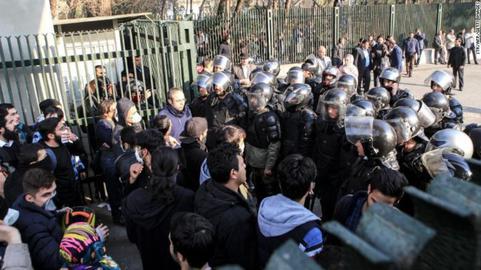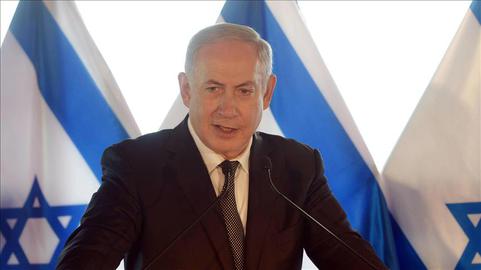Iranians who joined nationwide protests in late December 2017 and early January 2018 blame the Islamic Republic regime and the Supreme Leader Ayatollah Ali Khamenei for the country’s endemic corruption, poor economic conditions and mounting unemployment, according to new research published by the Saham News website.
In late December 2017 and early January 2018, Iran was rocked by nationwide protests against corruption, costly military interventions in Iraq and Syria, rising prices and unemployment. In some cases the protests led to violence by the security forces, and sometimes by the protesters. Some protesters chanted “Death to the dictator!” — referring to Iran’s Supreme Leader.
The new study, which looks at the causes of the unrest, was published on May 1 [Persian link]. It reveals that the protesters primarily blamed the Supreme Leader Ayatollah Ali Khamenei and the Islamic Republic’s regime for their troubles. It cites “the increase in the working-age population and the relative inability of the government to create jobs for them,” “the disappointment of voters in Rouhani, the government and the regime,” and “the struggle over access to natural resources” among the main factors for the protests. It also reveals that people believe the regime and the government “do not hear their voices.”
The study states that the protests spread to 87 Iranian cities and towns. Of the 27 cities in the province of Khuzestan, nine were scenes of protests. The province next highest in terms of numbers of protests was Isfahan Province, where eight out of 24 towns staged protests.
In 37 towns, or 8 percent of Iranian towns, the protests led to violence, the study reveals. On December 31, the fourth day of the unrest, protests spread to 33 cities. According to the study, Isfahan Province witnessed the longest duration of protests, with six days of street demonstrations, and Khuzestan province came next, with five days.
Through reviewing the available videos from the protests, the study reports that 9.5 percent of demonstrators shouted “Death to the dictator!” — the highest percentage for any slogan shouted at the recent widespread protests. Next came “Not Gaza, nor Lebanon; my life for Iran.” “Death to Rouhani” represented 2.6 percent of the chants and “Death to Khamenei” was chanted by 1.9 percent of the demonstrators. “People live like a beggar; the Leader lives like a god” had a 2.1 percent share of the slogans. All in all, the study found that anti-Khamenei slogans were the dominant theme of the chants, with 24 percent of all chants expressing anger toward or dissatisfaction with the Supreme Leader.
“People see Ayatollah Khamenei as the most important decision-maker in Iranian politics,” the report concludes, “so during political and economic protests people hold him more accountable than anybody else.” During the protests, Razavi Khorasan, Qom and Kermanshah provinces witnessed the least amount of chants against the Supreme Leader.
Within the slogans chanted during the unrest, 10 percent were against the regime, eight percent were about Iran’s economic situation and seven percent against the clergy. The province of Isfahan was the scene of the longest and most widespread protests. Next came the provinces of Khuzestan, Lorestan and Hamedan.
The study concludes that the protests were more intense and widespread in provinces where the size of the working-age population had increased in 2017.
The study also provides a province-by-province analysis of the key triggers for protests.
Isfahan:
In Isfahan, water shortage was the most important issue pushing people to demonstrate. Next came the low ratio of average income of an urban household compared to its expenses. In this regard, the scenario is worse in Isfahan than in any other province. Isfahan also suffers from weak social capital — in other words, the province does not have strong networks or the sense of community required to support its people and help drive economic and other progress in the province. When looking at the macro level, Isfahan had the worst social capital of the 31 provinces analyzed. At the micro level, Isfahan came slightly higher, between 25th and 27th of 31 Iranian provinces.
Khuzestan:
The fight over access to water and the plague of dust storms were the two most important contributing factors to protests in this province.
Hamedan:
After Isfahan, Hamedan has the worst average household income-to-expense ratio. A considerable share of slogans chanted in this province was directed at Rouhani’s government and its failure to deal with this situation.
Mashhad and Razavi Khorasan
People in this province have the lowest level of trust in the Islamic Republic of Iran Broadcasting (IRIB), which has a monopoly on radio and TV broadcasts. After Isfahan, people in Mashhad also have the lowest level of satisfaction regarding the regime’s success in fighting poverty. On the other hand, when it comes to social capital, Raazavi Khorasan is 29th among Iranian provinces — above Isfahan and Tehran provinces.
Alborz:
Alborz has the lowest social capital at the micro level. The people of Alborz also have the lowest level of trust in the paramilitary Basij organization, an arm of the Revolutionary Guards.
Tehran:
At the macro level, Tehran province’s social capital stands at 30th out of 31 provinces, only higher than Isfahan province. The people of Tehran’s trust in the Basij also stands at 30, only higher than Alborz province.
Kermanshah:
Over the last two years, the province of Kermanshah has had the highest rate of unemployment among all provinces.
Zanjan:
Unhappiness with government performance played an important role in the protests in this province.
Qazvin:
Qazvin is one of the most underprivileged provinces in terms of social capital at all three levels (macro level and two micro levels). In addition, the people of Qazvin have low levels of trust in Iran’s government, clergy, the media, and in the Basij organization. Out of 31 provinces, Qazvin came 27th when it came to trust in the government; 27th in terms of trust in the clergy; 25th when looking at trust in the IRIB; and 27th regarding trust in the Basij. This could offer some explanation for the high level of violence that occurred in Qazvin during the protests.
Mazandaran:
Mazandaran has the second highest ratio of household income-to-expense in the country and this might explain the relatively low level of protests in the province.
Hormozgan:
The province of Hormozgan has the lowest level of unemployment in the country. The people of this province have the highest trust in IRIB after the people of Ardabil. They also tend to trust the clergy, coming second only after the province of North Khorasan.
Central:
The people of Markazi province have the lowest trust in the government, but its unemployment rate is 8.5 percent, one of the lowest among Iranian provinces. This might explain the low level of protests in the province.
Kurdistan:
After the Central Province, people of Kurdistan have the lowest level of trust in the government. However, considerable improvement in the rate of employment probably kept the level of protests in this province low.
North Khorasan:
North Khorasan has one of the lowest unemployment rates in the country, although it has the largest employment-age population among provinces. Nevertheless, the increase in the number of job-seekers might have contributed to the protests, as slogans against unemployment were clearly heard in late December and early January.
Yazd:
Yazd has one of the highest urban household income-to-expense ratios in Iran. Unsurprisingly, it was one of the calmest provinces during 2017-2018 protests.
More on 2017-2018 unrest in Iran:
Interior Minister Warns of Future Protests — But Offers no Solutions, March 2018
Does Khamenei’s Apology for “Injustice” Mean Anything?, February 2018
Revolutionary Guards “Consult” Reformists, February 2018
The Economic Despair Behind Iran’s Protests, January 2018
Unemployment and Inflation are an Explosive Mix, January 2018
Protester Labeled “Terrorist” after Beaten to Death in Custody, January 2018
Iranians Are 15% Poorer than a Decade Ago, January 2018
What Makes the Recent Unrest Different, January 2018
The Guards’ Conspiracy Theory About the Protests, January 2018
People Have Left the Reformists Behind, January 2018
Iran Officials Blame Each Other and Foreigners for Protests, December 2017
Protests in Iran Do Not Spare the Supreme Leader, December 2017
Iran Rocked by Second Day of Street Protests, December 2017
visit the accountability section
In this section of Iran Wire, you can contact the officials and launch your campaign for various problems


























comments